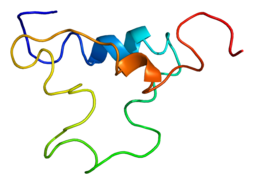Insulin-like growth factor 1 (IGF-1), also called somatomedin C, is a peptide that in humans is encoded by the IGF1 gene.[1] IGF-1 has also been referred to as a “sulfation factor” and its effects were termed “nonsuppressible insulin-like activity” (NSILA) in the 1970s.
IGF-1 consists of 70 amino acids in a single chain with three intramolecular disulfide bridges. IGF-1 has a molecular weight of 7,649 daltons.
IGF-1 is a hormone similar in molecular structure to insulin. It plays an important role in childhood growth and continues to have anabolic effects in adults. A synthetic analog of IGF-1, mecasermin, is used for the treatment of growth failure.
Its primary action is mediated by binding to its specific receptor, the insulin-like growth factor 1 receptor (IGF1R), which is present on many cell types in many tissues. Binding to the IGF1R, a receptor tyrosine kinase, initiates intracellular signaling; IGF-1 is one of the most potent natural activators of the AKT signaling pathway, a stimulator of cell growth and proliferation, and a potent inhibitor of programmed cell death.
 IGF-1 is a primary mediator of the effects of growth hormone (GH). Growth hormone is made in the anterior pituitary gland, is released into the blood stream, and then stimulates the liver to produce IGF-1. IGF-1 then stimulates systemic body growth, and has growth-promoting effects on almost every cell in the body, especially skeletal muscle, cartilage, bone, liver, kidney, nerves, skin, hematopoietic cell, and lungs. In addition to the insulin-like effects, IGF-1 can also regulate cell growth and development, especially in nerve cells, as well as cellular DNA synthesis. Insulin-like growth factor 1 receptor (IGF-1R) and other tyrosine kinase growth factor receptors signal through multiple pathways. A key pathway is regulated by phosphatidylinositol-3 kinase (PI3K) and its downstream partner, the mammalian target of rapamycin (mTOR). Rapamycins complex with FKBPP12 to inhibit the mTORC1 complex. mTORC2 remains unaffected and responds by upregulating Akt, driving signals through the inhibited mTORC1. Phosphorylation of eukaryotic initiation factor 4e (eif-4E) [4EBP] by mTOR inhibitor the capacity of 4EBP to inhibit eif-4E and slow metabolism [2].
IGF-1 is a primary mediator of the effects of growth hormone (GH). Growth hormone is made in the anterior pituitary gland, is released into the blood stream, and then stimulates the liver to produce IGF-1. IGF-1 then stimulates systemic body growth, and has growth-promoting effects on almost every cell in the body, especially skeletal muscle, cartilage, bone, liver, kidney, nerves, skin, hematopoietic cell, and lungs. In addition to the insulin-like effects, IGF-1 can also regulate cell growth and development, especially in nerve cells, as well as cellular DNA synthesis. Insulin-like growth factor 1 receptor (IGF-1R) and other tyrosine kinase growth factor receptors signal through multiple pathways. A key pathway is regulated by phosphatidylinositol-3 kinase (PI3K) and its downstream partner, the mammalian target of rapamycin (mTOR). Rapamycins complex with FKBPP12 to inhibit the mTORC1 complex. mTORC2 remains unaffected and responds by upregulating Akt, driving signals through the inhibited mTORC1. Phosphorylation of eukaryotic initiation factor 4e (eif-4E) [4EBP] by mTOR inhibitor the capacity of 4EBP to inhibit eif-4E and slow metabolism [2].
The IGF signaling pathway has a pathogenic role in cancer. Studies have shown that decreased levels of IGF lead to decreased growth of existing cancer cells. People with Laron syndrome have also recently been shown to be of much less risk to develop cancer. Dietary interventions and modifications such as vegan diets shown to down regulate IGF-1 activity, has been associated with lower risk of cancer.
In recent years, the researchers pay more and more attention to the the relationship between IGF1 and cancer. For example, the importance of the IGF system in carcinogenesis has been established for many solid cancers. It is well known that individuals with higher circulating levels of the IGF1 ligand present an increased risk of cancer. However, therapies with monoclonal antibodies targeting the IGF1 receptor (IGF1R) have been largely unsuccessful. One of the potential reasons for this failure is the existence of the highly homologous insulin receptor (IR), which appears to be at least equally efficient as the IGF1R in the transition of mitogenic signals to the nucleus and promotion of cell growth. Furthermore, IGF1 and insulin receptors can form hybrid receptors sensitive to stimulation of all three ligands of the system: insulin, IGF1, and IGF2. Although the connection between insulin, diabetes, and cancer has been established for years now, clear evidence that demonstrate the redundancy of insulin and insulin receptors and insulin-like growth factors and their receptors in cancer is missing. [3].
Karebay can synthetic IGF1 with Modified amino acids, so that scientists can knew more details about its molecular mechanism.
karebay (www.karebaybio.com) has a professional team devoted to peptide products synthesis and development. We offer high-quality peptide synthesis products for sale around the world, including over 1,000 catalog peptides, and nearly 100 pharmaceutical peptides and cosmetic peptides products.
Reference [1] Carpenter V, et al. (February 2008). “Mechano-growth factor reduces loss of cardiac function in acute myocardial infarction”. Heart Lung Circ 17 (1): 33–9. [2] Rosenbloom AL (2007). “The role of recombinant insulin-like growth factor I in the treatment of the short child”. Curr. Opin. Pediatr. 19 (4): 458–64. [3] Trajkovic-Arsic M,et al.(April 2013) The role of insulin and IGF system in pancreatic cancer. J Mol Endocrinol. 50(3):R67-74.




